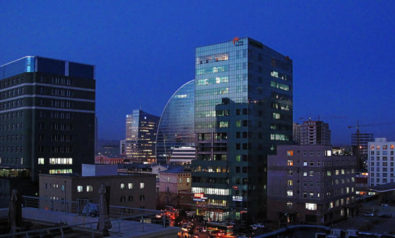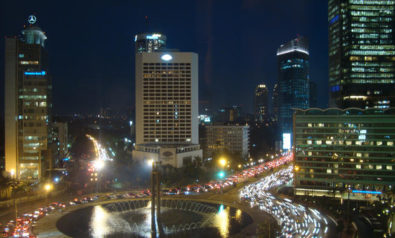While Indonesia's economy is on the verge of becoming the leading one in Southeast Asia, there's still work left to do for the country's leaders.
In the middle of Jakarta, there is a statue of Krishna and Arjuna on a chariot pulled by eleven horses in full gallop. The statue is an appropriate image for the Indonesian economy. Just as in the great epic, the Mahabharata, in which Krishna and Arjuna are central characters, Indonesia faces huge challenges and how it deals with them will determine the long-term health of its economy.
The Indonesian economy has been on a roller coaster ride ever since its independence from the Netherlands. Under its first President Sukarno, Indonesia was influenced by socialism like other newly independent countries such as India. Economic nationalism in combination with political strife led to 1000% inflation, increased poverty and hunger, and economic chaos in the 1960s. In the 1970s, the economy grew fast high, averaging over 7% from 1968 to 1981 thanks in so small part due to high oil prices. This growth slowed down in the 1980s. Declining oil prices and increased regulation were to blame. Economic reforms were therefore introduced later in the decade and led to a growth rate of over 7% from 1989 to 1997.
The Asian financial crisis of 1997 hit Indonesia like a tsunami and, in 1998, the economy contracted by 13.13%. This contraction occurred because of systemic weaknesses and poor IMF policy prescriptions. Corruption, mismanagement and public indebtedness had created an unsustainable economy and IMF’s draconian fiscal recommendations further cut the legs from an economy already floundering on its feet. The Indonesian economy took a while to recover and it was only in 2004 that the economy grew more than 5%. Since then growth has been largely robust and, in 2011, the economy grew at its fastest rate for 15 years, at 6.5%, the highest since the 1997-98 Asian financial crisis.
This time it is different, or is it?
High growth rates are not new to Indonesia but this time things seem to be different. By the end of this year or by early next year, Indonesia is likely to join the club of 15 countries with an annual GDP of above $1 trillion. In 2011, foreign direct investment reached a record $19.3 billion and exports surged by 29 percent, reaching $203.62 billion. Fitch Ratings in December granted Indonesia an investment-grade credit rating after 14 years of junk status and Moody’s Investors Service followed in January. Net foreign debt is now less than 10% of GDP and there is a real possibility that Indonesia might become a net creditor by the end of next year. There is more good news. Indonesia’s bourse did well in 2011. It was one of Asia’s best-performing markets, gaining 3.2 percent at a time when other exchanges suffered due to the global financial crisis. In April this year, the World Bank noted that “despite both domestic and international risks, Indonesia’s economic fundamentals are solid.” It projected Indonesia’s growth for 2012 at 6.1% and for 2013 at 6.4%.
Indonesia has seen rapid economic growth before and the question arises whether this growth is sustainable or even real. Professor Philip Nichols of Wharton believes so. He is of the opinion that Indonesia’s large internal market has enabled it to weather the global economic crisis relatively unscathed. According to him, Indonesia is finally beginning to climb out of the “institutional hole” that it found itself in pre-1997 when rapid growth papered over deep faults and eventually led to a crash. Indonesia’s large internal market – two-thirds of its consumption is internal – makes its economy resilient. Furthermore, the country has better institutions, less distortion and greater reliance on markets.
Yet, the basis for Indonesian growth is still consumption and commodities. The country is in the middle of an unprecedented consumer boom. Scooters, cars, smartphones, ice-creams and skincare products are all in demand. The middle class is growing and newly affluent Indonesians are spending. Big brand names are visible on televisions, hoardings and on Jakarta’s streets. When it comes to commodities, the growth of China and India has given a fillip to the Indonesian economy. Both demand coal and gas while the entire world is hungry for palm oil.
While commodities are driving growth, they are also creating the risk of a Dutch disease for Indonesia. The Dutch disease refers to the fact that an increase in exploitation of natural resources leads to a decline in the manufacturing sector in the economy due to exchange rate appreciation. Manufacturing has indeed lagged behind almost every other sector of the economy. This is not healthy for the long term and Professor Richard Herring, Co-Director, Wharton Financial Institutions Center believes that Indonesia should focus on infrastructure and human capital formation to wean itself away from its resource base. Other regional competitors such as Vietnam have been focusing on education and infrastructure while Indonesia has been lagging behind on both fronts.
Indonesia is ranked 124th out of the 187 countries surveyed by the 2011 Human Development Index. Both its schools and universities are not in the rudest of health and, apart from the University of Indonesia, its universities have slipped in the 2011 World University Rankings. The quality of Indonesia’s labor force is poor. The overall level of educational attainment is relatively low, where around 50% of the labor force has an elementary school certificate or lower. Only around 40% of the labor force has secondary education and a little over 5% have diplomas and university degrees. This is a problem of underdevelopment that in turn leads to a problem of labor underutilization, such as unemployment and underemployment.
Indonesia’s terrible infrastructure adds immensely to production costs, denting its competitiveness not only globally but also regionally. It desperately needs ports, roads, railways, power and broadband. Broadband use is only about 18 percent of all Internet users in Indonesia. More importantly, while its neighbors are busy building new ports or expanding old ones, Indonesia is paying little attention to infrastructure. The World Bank’s Logistics Performance Index ranked Indonesia at 75th out of a total of 155 countries surveyed. Malaysia, Thailand, Philippines and Vietnam are all ranked above it and the differential is only likely to increase as they are all investing infrastructure. Indonesia faces gradual erosion of its competitive advantage unless its government gets its act together and focuses on education and infrastructure.
What about the government?
Indonesia’s government does not exactly inspire confidence. Like other emerging economies, the country suffers from three familiar problems – poor institutions, bad politics and high corruption.
As a young democracy Indonesia’s institutions are still evolving. The highly decentralized political system does not make this process easy – decision making is arduous and protracted. Forging institutions for a sprawling archipelago with a population of 240 million people from over 300 ethnic groups speaking 737 languages is tough. This is made tougher because of a toxic legacy – the Dutch colonial rule followed by decades of authoritarian rule after independence in 1945. One of legacies is a gargantuan bureaucracy that stymies economic growth. Another is the lack of transparency and the randomness of regulations. Consequently there is little rule of law. The courts function haphazardly, the process is tardy and the legal outcomes are highly uncertain. Enforcement of laws is poor, judges still face political interference and the experience and educational standards of lawyers and judges leave much to be desired.
To add to Indonesia’s woes, its political system is murky and fragmented. President Yudhoyono is frequently ignored by his ministers. He is the head of a six-party coalition and seeks to rule by consensus. This is particularly difficult with the contending agendas and interests of not only the different parties but also the various politicians. These politicians draw their power from patronage, which means that there is an incentive to curry favors by catering to special interests. This happens to some degree in all economies and the US is no exception. What marks Indonesia out is the scale to which pork barrel politics is a part of the political process.
The worst example of pork barrel politics are fuel subsidies. Most of their benefits go the wealthier segments of the population. According to the 2009 household survey conducted by the World Bank, 40% of the direct benefits to households from fuel subsidies go to the richest 10% of households, and less than 1% of the subsidies go to the bottom 10%. Furthermore, with the price of Brent Crude Oil topping $105 a barrel, fuel subsidies are costing the exchequer a huge sum. Recent attempts to cut back the subsidies have resulted in street protests and parliamentary rebellion. As a result, fuel subsidies remain unchanged. In the light of the continuing high price of oil, Shubham Chaudhuri, the World Bank’s lead economist in Indonesia, remarked last month that the government would end up spending between $20 billion and $30 billion every year on wasteful subsidy instead of using it “for roads, health care, alternate energy sources and helping poor households.” In other words, more than the fiscal cost of fuel subsidies, it is the opportunity cost of the spending that is a matter of concern.
Another matter of concern is corruption. It is a major stumbling block for sustained economic growth. There are plenty of scandals involving people in high places. For instance, the treasurer of the ruling party is on trial for defrauding the exchequer to the tune of $365 million for inflating construction tenders for the 2011 Southeast Asian Games. He claims that he did this to raise funds for the party and not for personal gain. Senior party figures and even ministers are now suspects. This scandal is only a manifestation of widespread corruption that pervades all aspects of government and acts as a major drag not only on economic growth but also on the quality of lives of the Indonesian people.
So what does the future hold?
Professor Richard Herring says, “Indonesia could be one of the leading economies in the world.” To get there though the country will need to implement reforms. At the moment, the International Financial Corporation and World Bank rankings for doing business rank Indonesia at 129th out of a total of 183 countries. The same index ranks Indonesia at 155th for starting a business, at 156th for enforcing contracts and at 161st for getting electricity. Over time, things are likely to get better. While fuel subsidies have been retained, a new land acquisition act has been passed in December. This is likely to increase spending on infrastructure and already there are signs that this might be coming true.
Finally, to revert to the image with we started, Indonesia is unique in its tolerance and syncretism. No Islamic country has a statue of Krishna and Arjuna in the middle of its capital. Unlike Malaysia which is seeing an increase in religiosity, Indonesia is a rambunctious democracy where governments change. As it evolves, Indonesia is likely to elect a leadership with the will to push through reforms, develop institutions, and improve education and infrastructure. For all the challenges, Indonesia’s future is one of great promise.
The views expressed in this article are the author's own and do not necessarily reflect Fair Observer’s editorial policy.
Support Fair Observer
We rely on your support for our independence, diversity and quality.
For more than 10 years, Fair Observer has been free, fair and independent. No billionaire owns us, no advertisers control us. We are a reader-supported nonprofit. Unlike many other publications, we keep our content free for readers regardless of where they live or whether they can afford to pay. We have no paywalls and no ads.
In the post-truth era of fake news, echo chambers and filter bubbles, we publish a plurality of perspectives from around the world. Anyone can publish with us, but everyone goes through a rigorous editorial process. So, you get fact-checked, well-reasoned content instead of noise.
We publish 2,500+ voices from 90+ countries. We also conduct education and training programs
on subjects ranging from digital media and journalism to writing and critical thinking. This
doesn’t come cheap. Servers, editors, trainers and web developers cost
money.
Please consider supporting us on a regular basis as a recurring donor or a
sustaining member.
Will you support FO’s journalism?
We rely on your support for our independence, diversity and quality.










Comment